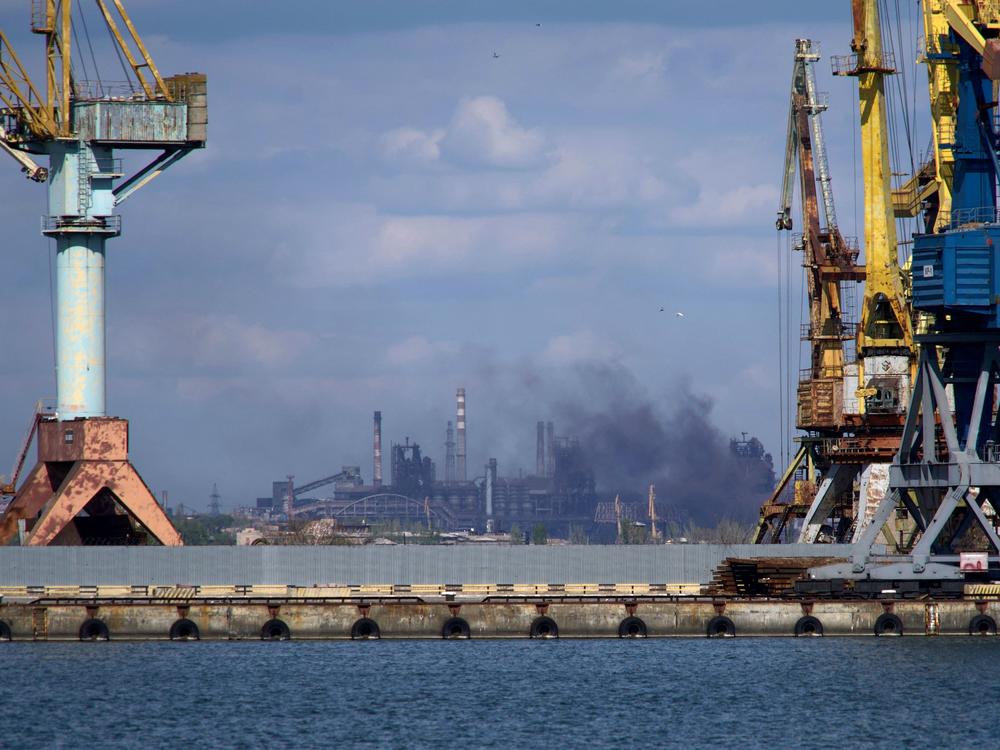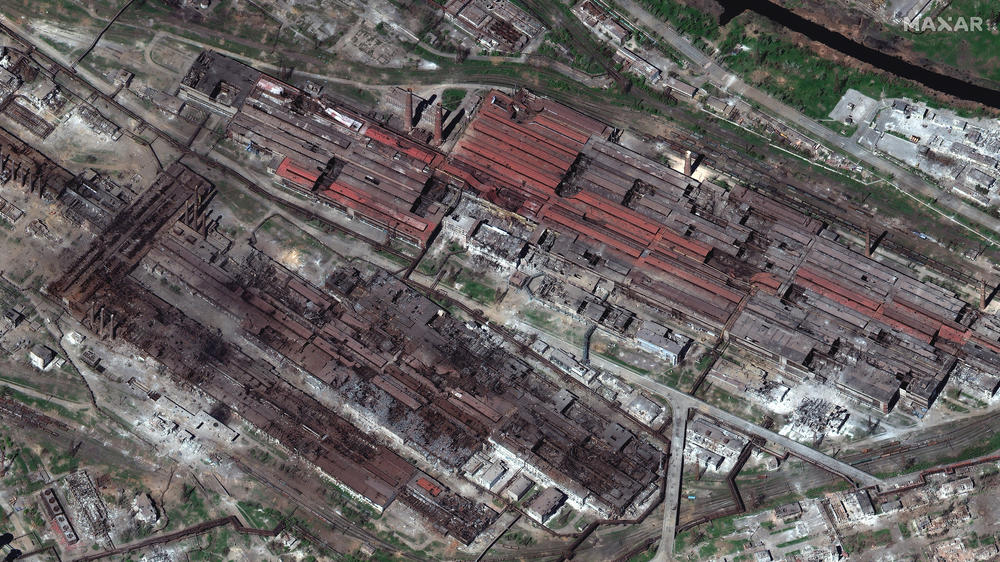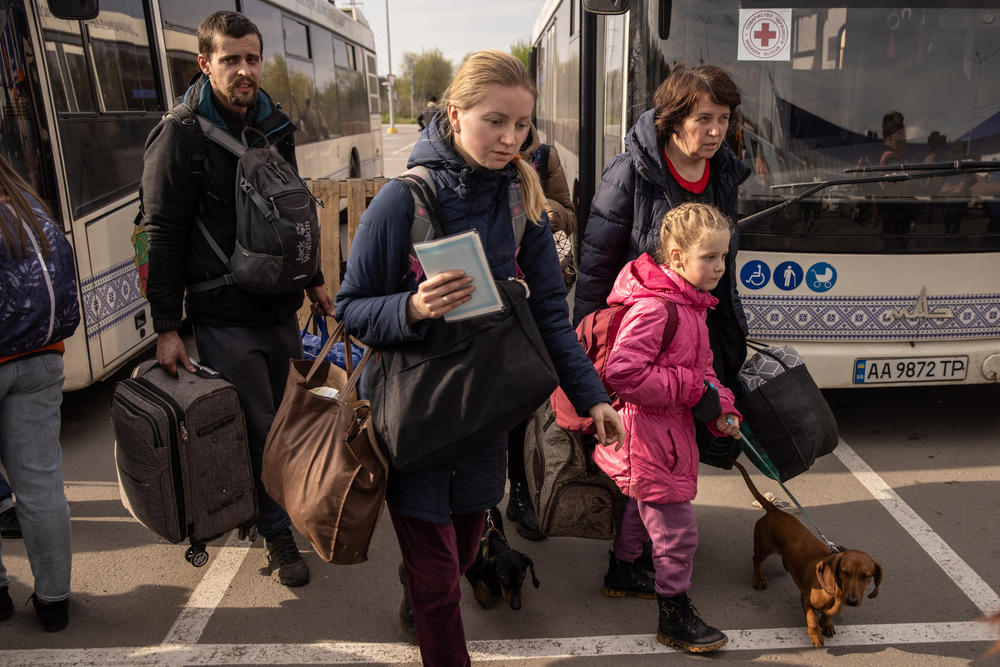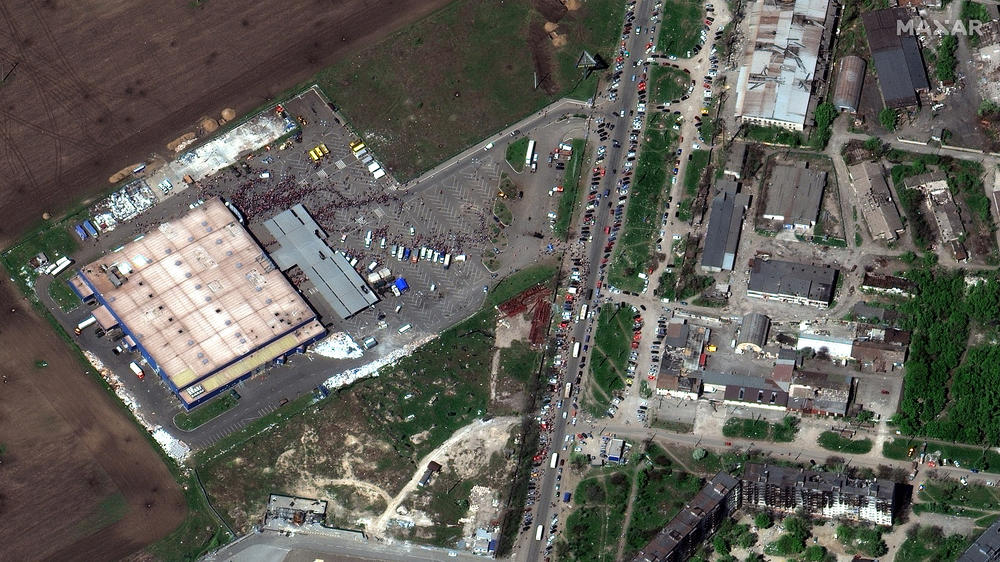Section Branding
Header Content
How a massive steel plant became the center of Ukraine's resistance in Mariupol
Primary Content
The final stand for the Ukrainian city of Mariupol began this week as Russian forces entered the hulking Azovstal steel plant at the heart of the besieged city, where thousands of Ukrainian soldiers and civilians have been hiding for weeks.
"Heavy, bloody battles are being fought," said Capt. Sviatoslav Palamar, the deputy commander of the Ukrainian forces inside the plant, in a video released Thursday on Telegram.
The Azovstal plant has become the epicenter of the battle for Mariupol. Ukrainian officials say that Russian forces entered Azovstal, a massive coastal complex, for the first time on Tuesday — just days after about 150 civilians were evacuated in a convoy organized by the United Nations and the International Committee of the Red Cross (ICRC).
With fighting now inside the plant, efforts to evacuate the remaining civilians have intensified.
"We are negotiating and hope to continue rescuing people from Azovstal, from Mariupol. There are still civilians. Women, children," said Ukrainian President Volodymyr Zelenskyy in his overnight address Thursday.
Zelenskyy has called on Russia to commit to a longer cease-fire in order to evacuate civilians. "It takes time to just lift people out of those basements, out of those underground shelters. In the current conditions, we cannot use special equipment to clear the debris," he said.
What is the Azovstal steel plant?
First operational in 1933, Azovstal is one of the largest metal plants in Europe. For decades, it was key to the Soviet Union's railroad system and shipbuilding efforts. It was privatized in the 1990s after Ukraine's independence.
The massive complex of warehouses, railroad tracks and industrial-strength furnaces sits on 4 square miles along Mariupol's coast, across the river from the city's downtown district. Before the invasion, the plant employed more than 10,000 people, according to company documents.
Buried underneath the plant is a network of bunkers and tunnels dating back to the Soviet era. For weeks, these subterranean spaces have become shelters for hundreds of civilians, many of them Azovstal employees and their family members.
Evacuees describe the tunnels as an enormous maze, "like a big city," too dark and tangled to navigate. "You couldn't see what was in front of you, so you stay in places you know," said Maiia Krylova, a 14-year-old who evacuated this week to Zaporizhzhia with her mother, Anna Krylova.
Azovstal has been a battleground before. German forces attacked the plant during World War II. In 2014, employees at the plant took shelter in the underground bunkers when separatists tried to take Mariupol.
How did Azovstal come to be at the center of the fight over Mariupol?
Mariupol has been a focus of the Russian military from the beginning of its invasion. Mariupol's coastal location, situated on the Sea of Azov between the border with Russia and the Crimean Peninsula, makes the city a strategic prize for Russia.
Russian forces reached Mariupol just days after the invasion began on Feb. 24, and they encircled the city by early March.
Through weeks of intense street fighting and relentless shelling, Russia pushed Ukrainian forces farther and farther back until they were pinned inside the Azovstal plant, their backs to the coast, with nowhere else to retreat.
On April 21, Russian military officials declared victory in Mariupol after capturing the rest of the city. Ukraine has not surrendered.
Evacuees who sheltered there for weeks as fighting raged around them described their experiences to NPR.
"The last few days we were there, I became convinced that the steel plant was going to collapse on us. How could it stand up to this kind of bombing?" said Alex Dybko, an English teacher who sheltered in the plant for weeks with his wife and son before evacuating to Zaporizhzhia this week.
What's the situation there now?
Hundreds more civilians are still trapped inside the plant, along with about 2,000 Ukrainian soldiers, Ukrainian authorities estimate. Stores of food, water, medical supplies and hygiene products are running low, people inside the plant say.
Stanislav Kerod, a naval border guard inside the plant, told NPR this week that the situation was "catastrophic."
"It's getting worse every day. We can't do anything about it because we're trapped. No one can bring us any kind of aid," he said. "We're trying to help civilians with food and medicine. We will not leave them hungry and fighting for survival, but we can only share what we have."
It's unclear when the remaining civilians will be evacuated. Ukrainian military officials have also called for the safe transport of wounded soldiers and the bodies of the dead outside Mariupol.
"Give us the chance to pick up the bodies of dead soldiers so that Ukrainians can say goodbye to their heroes," Palamar, the deputy commander, said Thursday.
What about the rest of Mariupol?
Russia hopes to claim complete control of Mariupol by May 9 — a symbolically important day that Russia celebrates as the anniversary of the Soviet Union's defeat of Nazi Germany — military analysts say, including those at the Washington, D.C.-based Institute for the Study of War.
Ukrainian officials say about 100,000 civilians remain in the city, which was home to about 430,000 residents before the war.
Leaving is dangerous and logistically difficult, aid agencies and evacuees report: Shelling is a constant threat, roads and bridges are blocked or destroyed, and many who remain do not have access to vehicles.
Despite the difficulties, aid agencies say they are still working to evacuate people.
"It is an immense relief that some civilians who have suffered for weeks are now out," said ICRC President Peter Maurer in a statement this week. "The ICRC hasn't forgotten the people who are still there, nor those in other areas affected by the hostilities or those in dire need of humanitarian relief, wherever they are. We will not spare any effort to reach them."
Mariupol Mayor Vadym Boychenko says more than 20,000 civilians have died in the city. The damage to the city has been massive.
U.S. officials believe that Russia could be looking to annex the Donetsk and Luhansk regions of eastern Ukraine as soon as mid-May. Mariupol is part of the Donetsk oblast.
"We believe that the Kremlin may try to hold sham referenda to try to add a veneer of democratic or electoral legitimacy. This is straight out of the Kremlin's playbook," Michael Carpenter, the U.S. ambassador to the Organization for Security and Co-operation in Europe, told reporters Monday.
Copyright 2022 NPR. To see more, visit https://www.npr.org.




